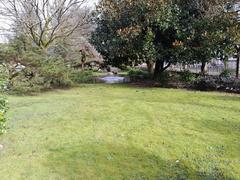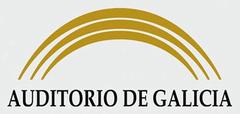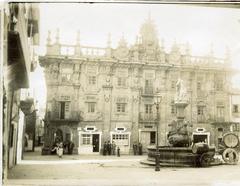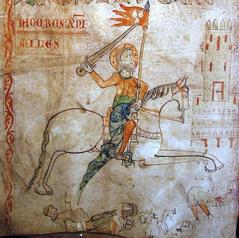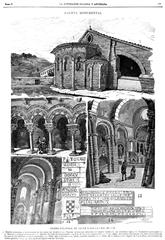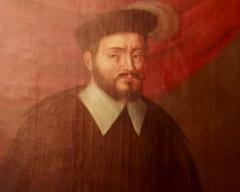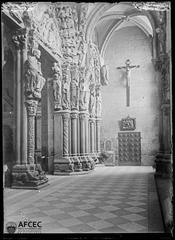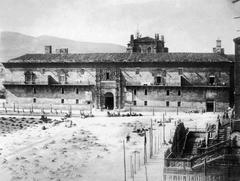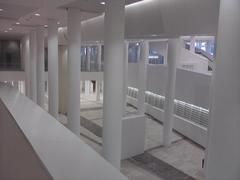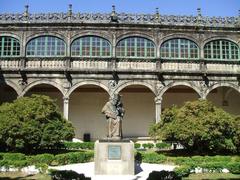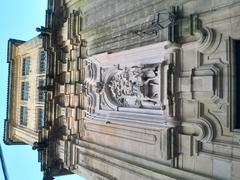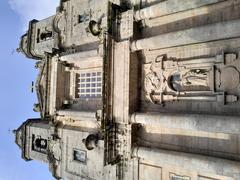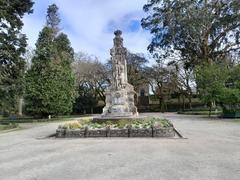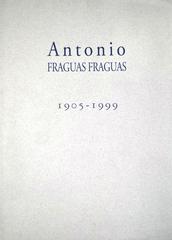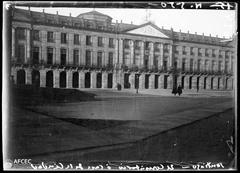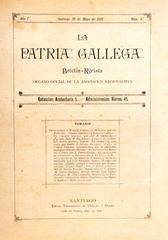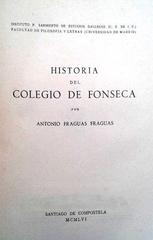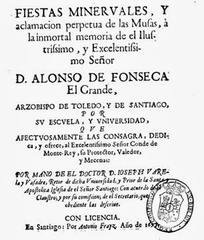
Church of Saint Fructuosus Santiago de Compostela: Visiting Hours, Tickets, and Travel Guide
Date: 04/07/2025
Introduction
The Church of Saint Fructuosus (Igrexa de San Fructuoso) is a captivating yet often overlooked monument in the heart of Santiago de Compostela, a city renowned as the final destination of the Camino de Santiago pilgrimage and a UNESCO World Heritage site. Dedicated to Saint Fructuosus—an early medieval monastic reformer and key figure in Galicia’s Christian history—this 18th-century church embodies the region’s intertwined religious, cultural, and architectural traditions. Its location near iconic sites such as the Cathedral of Santiago de Compostela and the Plaza del Obradoiro makes it an essential stop for pilgrims and travelers seeking a deeper understanding of Galicia’s spiritual landscape (World Travel Guide, Spain.info).
This guide offers a comprehensive overview of the Church of Saint Fructuosus, including historical context, architectural highlights, practical visitor information, accessibility, and tips for enhancing your visit.
Historical Background & Significance
Saint Fructuosus: His Life and Legacy
Saint Fructuosus was a 7th-century nobleman from the region of El Bierzo, León, whose profound religious zeal led him to establish several monasteries throughout Galicia and León. As Bishop and later Archbishop of Braga, he championed monastic discipline, authored influential monastic rules, and mediated between secular rulers and the church. His dedication to poverty, obedience, and communal living shaped the spiritual landscape of northwestern Spain and northern Portugal (World Travel Guide). After his death, his reputation for holiness and miracles ensured his veneration throughout Galicia, with his relics becoming objects of local pilgrimage.
The Church’s Role in Santiago’s Spiritual Fabric
The Church of Saint Fructuosus is one of several Galician churches dedicated to the saint, reflecting the enduring impact of his life and works. Its proximity to the Camino de Santiago pilgrimage route underscores its historical significance as a spiritual waypoint for pilgrims, complementing the larger and more famous Cathedral of Santiago de Compostela (Caminodesantiago.gal).
Architectural and Artistic Highlights
Exterior: Galician Baroque Elegance
Constructed primarily in the 18th century, the Church of Saint Fructuosus epitomizes Galician Baroque architecture. Its facade features dynamic forms, symmetrical pilasters, sculpted reliefs, and imposing bell towers, all crafted from local granite—ensuring both beauty and durability in Galicia’s humid climate (Spain.info). The main entrance, with its robust columns and triangular pediment, provides a striking visual welcome.
Interior: Artistry and Devotion
The church’s interior follows a Latin cross plan, with a barrel-vaulted nave and a domed crossing that bathes the space in natural light. Noteworthy features include:
- A gilded Baroque retablo (altarpiece) at the main altar, depicting Saint Fructuosus in episcopal vestments surrounded by saints and angels (PlanetWare)
- Side chapels adorned with richly gilded altarpieces and expressive saintly figures
- Stone altarpieces and stained glass windows illustrating scenes from Saint Fructuosus’s life and Galician pilgrimage motifs
- Historic tombs, wooden choir stalls, and traditional Galician religious art
The church’s modest size fosters a serene, contemplative atmosphere, ideal for reflection away from the crowds of the Praza do Obradoiro.
Pilgrimage and Community Life
The Church of Saint Fructuosus serves both the local community and visitors. Regular Masses, feast day celebrations (notably on January 21st), and religious processions form an integral part of its liturgical calendar (travelinfusedlife.com). During Holy Years and the Feast of Saint James (July 25th), the church actively participates in city-wide religious and cultural events, welcoming increased numbers of pilgrims and worshippers (Then We Walked).
As a waypoint for Camino de Santiago pilgrims, the church offers a quieter spiritual environment for prayer and thanksgiving, reinforcing the values of sacrifice and perseverance embodied by its patron saint (catholicsaints.day).
Practical Visitor Information
Location and Access
Located at Trinidade, 15705 Santiago de Compostela, the church is within easy walking distance of the city center, the Cathedral, and major squares (Caminodesantiago.gal). The pedestrian-friendly historic district encourages exploration on foot. Public transportation and taxis are available nearby, with main train and bus stations about 1.5 km away.
Visiting Hours
- Monday to Saturday: 10:00 AM – 6:00 PM
- Sunday: 12:00 PM – 4:00 PM
Hours may vary during religious festivals or special events. For the latest updates, consult the Turismo de Galicia website or church notices.
Tickets and Entry
Admission is free; no tickets are required. Donations are welcomed to support ongoing preservation and community activities.
Accessibility
The church is wheelchair accessible, with ramps at the entrance and accessible restrooms. Note that uneven stone floors may require caution. There is no dedicated disabled parking nearby, but drop-off zones are available.
Dress Code and Etiquette
- Modest attire (shoulders and knees covered; hats removed inside) is required
- Maintain silence, especially during services
- Photography for personal use is allowed without flash or tripods; commercial photography requires permission
Guided Tours, Events, and Enhancing Your Visit
- Guided Tours: Offered occasionally, especially during peak pilgrimage seasons and special events. Inquire at local tourist offices or via the church’s website.
- Special Events: The church hosts liturgies, processions, and sacred music concerts during major feast days and Holy Years.
- Travel Tips: Visit early in the morning or late afternoon for a peaceful experience. Combine your visit with nearby landmarks such as the Cathedral of Santiago de Compostela, Monastery of San Martiño Pinario, and Praza do Obradoiro for a comprehensive cultural tour (Trevor Huxham).
Responsible Tourism & Preservation
Support the preservation of this living monument by respecting visitor guidelines, making voluntary donations, and participating in guided tours. Avoid touching artworks or liturgical objects, and silence mobile devices to maintain the sacred ambiance. Your responsible behavior ensures the church’s continued role in Santiago’s community and heritage (Caminosantiago Compostela).
Frequently Asked Questions (FAQ)
Q: What are the visiting hours of the Church of Saint Fructuosus?
A: Typically Monday–Saturday from 10:00 AM to 6:00 PM and Sundays from 12:00 PM to 4:00 PM. Hours may vary during festivals and special events.
Q: Is there an entrance fee or are tickets required?
A: Entry is free. Donations are appreciated.
Q: Are guided tours available?
A: Yes, especially during peak seasons and feast days. Check with local tourist offices for availability.
Q: Is the church wheelchair accessible?
A: Yes, with ramps and accessible restrooms. Caution is advised due to some uneven flooring.
Q: Can I take photographs inside the church?
A: Personal photography is permitted without flash or tripods. Commercial photography requires prior approval.
Q: What is the dress code?
A: Modest clothing covering shoulders and knees is required; hats must be removed inside.
Nearby Attractions
- Cathedral of Santiago de Compostela: The city’s iconic religious landmark (Caminoways)
- Monastery of San Martiño Pinario: A monumental Benedictine site with rich artistic treasures
- Praza do Obradoiro: The main square, surrounded by architectural masterpieces
Visuals and Interactive Resources
For a virtual preview, high-resolution images and interactive maps are available on official tourism websites, allowing for better planning and orientation.
Conclusion
The Church of Saint Fructuosus is a spiritual and architectural jewel within Santiago de Compostela’s historic center. Its rich history, accessible location, and vibrant liturgical life invite both pilgrims and tourists to reflect on Galicia’s enduring religious traditions. Whether you are drawn by the church’s art, its historical resonance, or its peaceful sanctuary, a visit here will deepen your appreciation of Santiago’s spiritual and cultural heritage. For the latest updates, event schedules, and travel tips, consult the Turismo de Galicia website and consider downloading the Audiala app for audio guides and insider recommendations.
References and Further Reading
- World Travel Guide: Santiago de Compostela History
- Nomads Travel Guide: Santiago de Compostela
- Spain.info: Santiago de Compostela
- Caminodesantiago.gal: Igrexa de San Fructuoso
- Turismo de Galicia: Santiago de Compostela
- Caminosantiago Compostela: Ultimate Visitor’s Guide
- Spiritual Travels: History of the Pilgrimage to Santiago de Compostela
- Walk the Camino: Santiago’s Historical Importance
- The Tourist Checklist: Cathedral of Santiago de Compostela
- Caminoways: Exploring the Architectural Marvels of the Cathedral of Santiago de Compostela
- Trevor Huxham: Top Churches in Santiago de Compostela
- Then We Walked: Worth Visiting Santiago de Compostela
- Travel Infused Life: Holy Year in Santiago
- Catholic Saints: Saint Fructuosus

